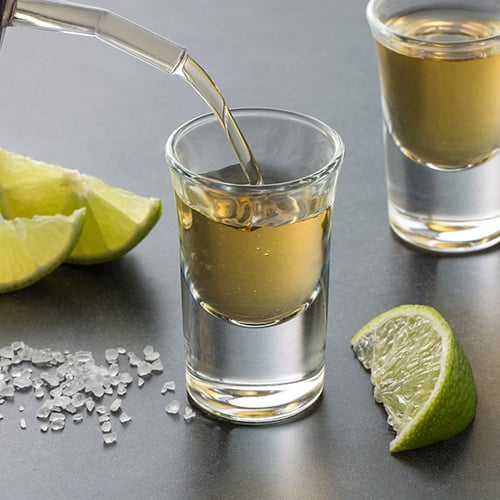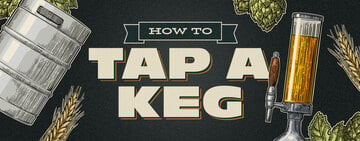How Many Ounces in a Shot Glass?
The shot glass is a foundational and essential piece of glassware in any successful bar. Whether you’re serving a round of shots during happy hour or using shots as measurements for mixed drinks, shot glasses are a staple of the bar scene. But, are all shot glasses the same size? Before you open a bar, it's important to understand shot glasses sizes and precise drink measurements, so you can price your drinks and keep your patrons safe.
Where to Buy Shot Glasses?
You can purchase shot glasses from online foodservice retailers like the WebstaurantStore and local brick-and-mortar restaurant supply shops.
Shop All Shot GlassesWhat Is a Shot Glass?

Shot glasses are petit bar glasses used to measure and serve small portions of liquor. They come in various sizes, usually ranging from less than an ounce to over 3 ounces. Shot glasses are most often used for drinking straight liquor (or “taking a shot”) but can also be used for measuring espresso for coffee drinks or serving personal dessert portions.
A shot glass usually features a thick bottom to help prevent it from breaking when customers slam them on the bar after taking shots. Many people collect customized shot glasses from their favorite bars and tourist destinations as souvenirs.
Shot Glass Sizes
The size of a shot glass can depend on where it was made and what type of shot glass it is. Some shot glasses will have thicker bottoms to make them look more full, earning them the title of “cheat glasses.” Others, known as shooters, will be tall and skinny, allowing them to be used for alternative purposes beyond serving alcohol.
How Many Ounces in a Shot?
The number of ounces in a shot glass depends on the size of the glass. Most shot glasses hold around 1.25 oz. to 1.5 oz., but there is no official standard size for a shot. Some shot glasses can be less than an ounce and others can be over 3 ounces, with the most common size being 1.5 oz.
Utah is the only state that has a strict definition of a shot, teaching bartenders to pour them consistently at 1.5 oz. You may also find different shot size definitions depending on which country you visit. In Australia, the average shot ranges from 1 to 2 oz., while a shot is usually .5 to 1.5 oz. in Germany.
So, is a shot glass one ounce? The answer is sometimes but not always. Be sure to check the fluid ounces of your shot glass before using it as a measuring system to serve your customers.
How Many Ounces in a Double Shot?
A double shot usually contains 3 to 4 ounces of liquor. Since there is no standard size for a shot glass, there is also no standard measurement for a double shot. More American bars would consider a shot to be 1.5 oz., making a double shot 3 oz.
How Many Tablespoons in a Shot?
If you’re operating under the “1.5 oz. equals a shot” measurement for your bar, then a shot would equal 3 tablespoons. This would in turn make a shot 9 teaspoons, but shot glasses vary in size so be sure to check their measurements before using them to serve customers.
How Many mL in a Shot Glass?
A 1.5 oz. shot is equivalent to 44 mL. Since shot glass sizes vary, you can find glasses that hold anywhere from 28 mL to around 90 mL depending on whether it's a single shot, double shot, or shooter.
Shot Measurements
Use our cheat sheet guide to shot glass measurements to make your cocktail recipe:
- Single Shot: 1.5 oz = 3 Tbsp. = 9 tsp. = 44 mL
- Double Shot: 3 oz = 6 Tbsp. = 18 tsp = 88 mL
How to Measure a Shot without a Shot Glass
If you are looking to measure a shot of liquor but find yourself without a shot glass, try using the following as a shot glass substitute:
- Jigger - A jigger is often used in bars to measure 1 to 2 oz. of liquor or flavoring syrup.
- Spoon - You can use a simple spoon from your flatware drawer to measure out the shot serving. Most flatware spoons hold approximately .5 oz., so a shot would be around three spoonfuls.
- Measuring spoon - If you have measuring spoons handy, you can pour a shot using a tablespoon 3 times or a teaspoon 9 times.
Importance of Precise Shot Measurements

The inconsistent measurement of a shot isn’t just about snubbing customers. You’ll want to make sure your shots are precisely measured for various reasons:
- The alcohol volume in a drink can negatively impact the overall flavor of a cocktail.
- Overpouring a shot increases the ABV of a drink and can cause customers to become more intoxicated than anticipated.
- Inconsistent shot measurements make it difficult to keep track of your supply and can negatively impact your profit based on your drink prices.
Difference between a Shot Glass, Jigger, and Shooter
Along with a shot glass, jiggers and shooters are often used in bars to measure and serve small portions of liquor. They are often interchangeable but do have some differences in usage and sizing that are essential for any bartender to learn.
Jigger vs Shot
While jiggers and shot glasses are both used to measure portions of liquor, a jigger is used as a measuring tool while a shot glass is mainly a drinking vessel. A bartender would generally not serve a drink in a jigger. A jigger is typically double-sided, providing the bartender with two sizing options to use while crafting mixed drinks so each drink is consistent in measurement.
How Many Ounces in a Jigger?
Most double-sided jiggers measure 1.5 oz. on one side and 0.75 oz. on the other side. Some are slightly larger and measure 2 oz. on one side and 1 oz. on the other side.
Shop All JiggersShooter vs Shot
A shooter is a type of shot glass that can be distinguished by its general shape and size. Shooters are typically narrow and tall shot glasses. They are often used for a double shot, tasting flight, or food presentation. Shooters can also be helpful for layered shots because of the extra capacity of the glass. Caterers love using shooters for hors d'oeuvres and desserts because they are perfect for small portion sizes.
How Many Ounces in a Shooter?
A shooter can usually hold anywhere between 2 to 5 ounces.
Shop All Shooter GlassesShot Menu

Now that you’re familiar with the capacity of shot glasses and shooters, you can craft some creative shots for your bar menu. Here are some shot menu options for you to choose from:
Tequila Shots
To be enjoyed by first licking salt off one’s hand, followed by a shot of tequila and a bite of a lemon or lime wedge.
Whiskey Shots
These are some iconic shots using various types of whiskey:
- Snake Bite: Whiskey and lime
- Red Snapper Shot: Crown Royal whiskey, amaretto, cranberry juice
- Three Wise Men: Johnnie Walker scotch, Jack Daniel's Tennessee whiskey, and Jim Beam bourbon
- Cinnamon Candy Apple: Cinnamon whiskey, sour apple schnapps, and red food coloring or cranberry juice
- Peanut Butter and Jelly Shot: Skrewball whiskey and Chambord liqueur
- Silver Bullet: Scotch whisky, gin, and a lemon twist
Vodka Shots
Vodka is a distilled alcohol that has a fairly mild flavor, making it perfect for mixing with other ingredients to create a unique shot menu.
- Kamikaze: Vodka, orange liqueur, and lime juice
- Blue Kamikaze: Vodka, blue curacao, and lime juice
- Mad Dog: Vodka, raspberry syrup, and hot sauce
- Freak Shot: Cucumber vodka and mint liqueur
- Black Russian: Vodka and coffee liqueur
Shot Glass History
The exact history of the shot glass is unclear, but it began being used in the United States in 1930 as the Prohibition Era was coming to an end. There are three common theories for how the shot glass got its name:
- Shot glasses came from Friedrich Otto Schott, the co-founder of a German glasswork factory, who made shot glasses for American markets.
- Shot glasses came from Old West cowboys paying for whiskey by trading bullets.
- Shot glasses came from pioneers using small glasses to collect the buckshot shrapnel they found in their game meat.
With precise shot measurements, you can control your supplies and budget while keeping your customers safe as they enjoy an evening in your bar.



